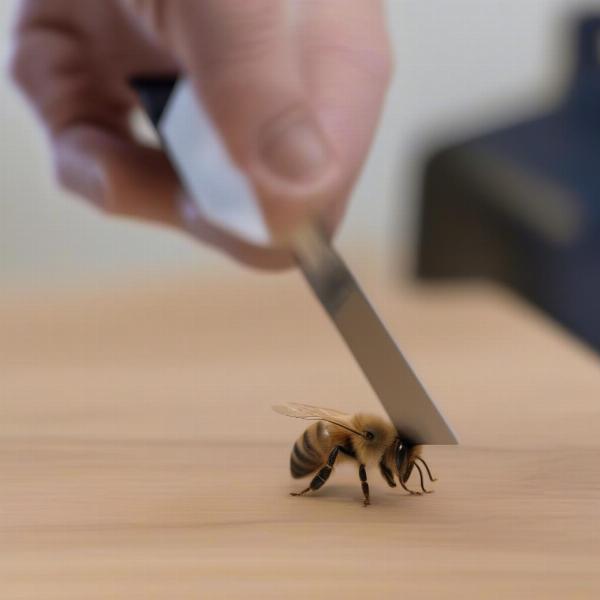Bee stings in dogs are a relatively common occurrence, especially during warmer months when bees are most active. Understanding the typical dog bee sting recovery time and knowing how to react can help ease your furry friend’s discomfort and prevent complications. This article will guide you through everything you need to know, from recognizing the symptoms to providing effective care and knowing when veterinary attention is necessary.
Recognizing a Bee Sting in Your Dog
A bee sting in a dog can manifest in various ways, depending on the location of the sting and the dog’s individual sensitivity. The most common sign is swelling at the sting site. You might also notice your dog licking, pawing, or biting at the area. If the sting is on the face, the swelling can be more dramatic and may involve the eyes or muzzle. Other symptoms can include whining, whimpering, or other signs of pain. In some cases, dogs can experience an allergic reaction, which can be life-threatening.
Dog Bee Sting Recovery Time: How Long Does it Take?
Most dogs recover from a bee sting within 24 to 48 hours. The swelling typically subsides gradually, and the associated pain diminishes over time. However, if the sting is inside the mouth or throat, the swelling can obstruct the airway and become a medical emergency. Similarly, an allergic reaction requires immediate veterinary intervention.
First Aid for Bee Stings in Dogs
 Removing Bee Stinger from Dog
Removing Bee Stinger from Dog
If you see the stinger, try to remove it by scraping it away with a flat object like a credit card. Avoid squeezing or pinching, as this can release more venom. Applying a cold compress to the area can help reduce swelling and soothe the pain. You can also make a paste of baking soda and water and apply it to the sting.
When to Seek Veterinary Care
While most bee stings are not serious, certain situations warrant a visit to the veterinarian. Seek immediate veterinary care if your dog shows signs of an allergic reaction, such as difficulty breathing, hives, vomiting, diarrhea, or collapse. Also, contact your vet if the sting is inside the mouth or throat, or if the swelling is severe or doesn’t improve within 48 hours. Your veterinarian may prescribe antihistamines or corticosteroids to manage the reaction and reduce inflammation.
Preventing Bee Stings in Dogs
Keeping your dog away from known beehives or areas with flowering plants can help minimize the risk of stings. Supervise your dog closely when outdoors, especially during warmer months. Avoid using scented products on your dog, as these can attract bees.
Conclusion
Knowing the dog bee sting recovery time and how to respond can help you provide the best possible care for your furry companion. While most bee stings are minor and resolve on their own, prompt action and veterinary care when necessary can prevent complications and ensure a swift recovery. Remember to monitor your dog closely for any signs of an allergic reaction and seek immediate veterinary attention if needed.
FAQ
- How can I tell if my dog is having an allergic reaction to a bee sting? Signs of an allergic reaction include difficulty breathing, hives, vomiting, diarrhea, facial swelling, and collapse.
- Can I give my dog Benadryl for a bee sting? Consult your veterinarian before giving your dog any medication, including over-the-counter antihistamines like Benadryl.
- What home remedies can I use for a dog bee sting? Applying a cold compress and a paste of baking soda and water can help reduce swelling and soothe the pain.
- How long does the swelling from a bee sting last in dogs? The swelling typically subsides within 24 to 48 hours.
- Are some dogs more allergic to bee stings than others? Yes, just like humans, some dogs are more sensitive to bee venom than others.
- What if my dog eats a bee? Stings inside the mouth or throat are particularly dangerous and require immediate veterinary attention.
- Can a bee sting be fatal to a dog? Yes, in rare cases, an allergic reaction to a bee sting can be fatal if not treated promptly.
Related Articles
- natural remedies for valley fever in dogs
- dog face swelling one side
- broken dog femur
- homemade food for dogs with pancreatitis
About ILM Dog
ILM Dog (ilmdog.com) is your trusted international resource for comprehensive dog care and wellness information. We provide expert advice on a range of topics, from breed selection and puppy care to senior dog health and dealing with emergencies like bee stings. Our mission is to empower dog owners worldwide with the knowledge and resources they need to provide the best possible care for their beloved companions. For expert advice or further assistance, please contact us: Email: [email protected], Phone: +44 20-3965-8624.